Brenau’s ‘Best and Brightest’
In front of the Academy building on the Gainesville campus a Women’s College student group huddles in clusters of three, each collectively molding handfuls of sand and water into shapes. Some insert little sticks of wood and pat the goop with their hands to solidify it. Others pour more water into the low spots, cheering as some of the water pools up.
At first glance it seems the project more befits a location on the backside of campus outside the Child Development Center in a sandbox full of five-year-olds. But no, insists Professor Heather Casey, the “walkin’ boss” for the project. These not only are college students, but they also are top students, members of Casey’s Honors 220 course.
“They were told to build a dam,” says Casey, who normally teaches political science instead of hydraulic engineering. And then she adds into skepticism’s un-poker-like face: “It’s not as easy as it looks.”
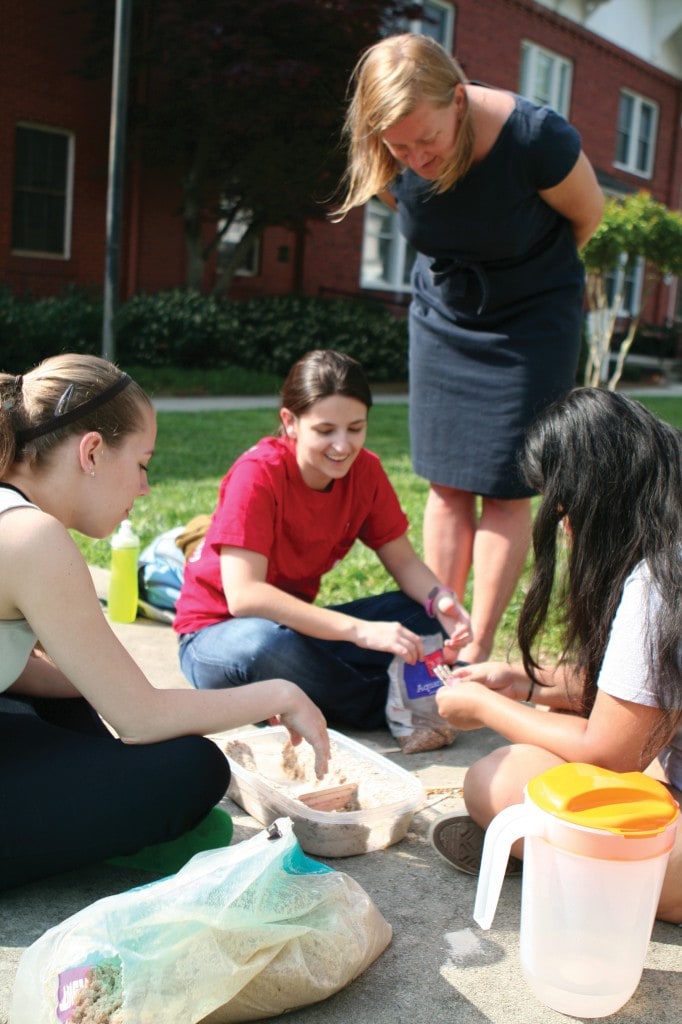
The honors students do not seem to think their labors are easy at all. Suzanna Broadwell, WC ’13, Morgan Davis, WC ’15, and Amy Walls, WC ’15 struggle with the concept of water’s sinking into porous sand. As an earth scientist, I can’t stand idly by, so I whisper, “Before you can have a dam, you must have a valley,” which probably violated Casey’s law. But honors students catch on quickly. Soon, a tiny river valley takes shape, then a ground-breaking ceremony for a miniature earthen dam.
Professor Winter Elliot, the current director of Brenau’s Honors Program, isn’t surprised by the students’ adaptability. “They possess inquiring minds, native curiosity, and a penchant for asking questions,” she says. “You can pick out a Brenau honors student from the toddler stage on. They’re the ones always asking ‘Why?’ And not accepting ‘because I said so’ as an answer.”
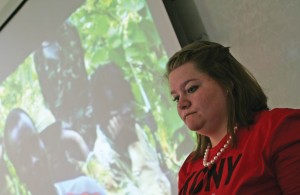
Gnimbin Ouattara plays on that same native skepticism as he guides his students in another course through the “World Understanding” portal of Brenau’s “Four Portals” liberal arts curriculum. Student presentations during his class time bounce between photos of bucolic African country scenes and images in gruesome detail of genocide, mutilations and all-out war.
“One of the objectives is to break down the basics of what they have ‘always known,’” Professor Ouattara says. “Most of these students grew up believing that we are ‘the civilized world,’’ and many other places are ‘uncivilized.’ Now they are put in the position of rebels, like Joseph Kony in Uganda, examining those two terms that they once were so sure about. When doubts develop, I can tell their minds are opening.”
Mind-opening experiences in Mary-Beth Looney’s honors course involve imagery, too, but it is a kinder, gentler type. A dimmed Disque Lecture Room in the John S. Burd Center brims with original art projections on the wall. Students, as well as faculty, dress up in continental-looking clothing, reminiscent of what Toulouse-Lautrec might have encountered on a stroll through the 19th century streets of his adopted hometown in France.
“We’re recreating 1889 Paris during the Exposition Universelle,” Looney explains. “The students are taking the roles of artists and critics, discussing and debating the value of fine art. It’s an exercise that teaches them the artistic essence of a culture and forces them to strategize. It can’t be done without applying a lot of critical thinking, another goal in the class.” The method, known as “Reacting to the Past,” is gaining momentum in the academic world, and Looney has already implemented a second learning game, set in Rome around the time of Julius Caesar’s demise, in which an Owens Hall classroom transmogrifies to the Forum, which is filled with would-be senators taking political debate to new heights.
The “Reacting to the Past,” or RTTP teaching method, in large measure is regarded as the brainchild of Barnard College History Professor Mark Carnes. In its most distilled form is merely a subset of role-playing and simulations in a learning environment. To teach employees how to deal with, say, sexual harassment in the workplace, the human resources director has a man assume the role of a female employee and a woman plays her male boss. It hits the very nerve center of the critical thinking process: putting yourself in the minds of those on the other side of an issue to understand how they might see a problem differently. To say that RTTP is catching on in higher education is an understatement. From Carnes’ initial introduction of RTTP in the Ivy League setting in 1995, the idea has expanded to curriculum in more than 300 U.S. colleges and universities, including the University of Georgia, and to other higher learning institutions around the world. There’s even a convention for RTTP: Barnard’s 11th gathering of the RTTP Institute last summer attracted 180 faculty members and administrators from 86 colleges and universities.
RTTP is also a subset of the concept of active learning, whose principal advocate, former Harvard President Derek Bok, sought to shift colleges and universities away from teaching based on mind-numbing lectures – sometimes delivered by genius-level faculty – to students who turn off their minds when they do not immediately find a connection to their lives. Active learning engages students basically to take charge of their own educations. The concept is fast expanding from merely an interesting way of teaching history into many other academic disciplines, including the sciences. Because students, in playing a role, cannot really separate their own thinking and knowledge from the role, the learning game automatically has relevance.
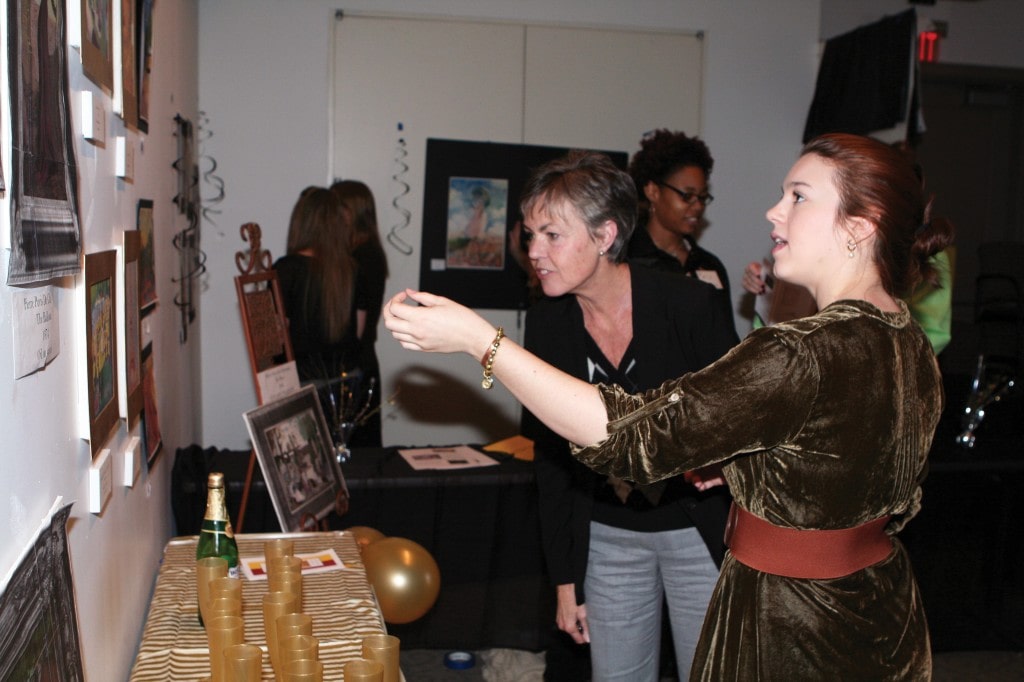
Carnes reported in The Chronicle of Higher Education last year that the strongest learning gains come from “pedagogies that feature teamwork and problem solving. Experience also suggests that teams work harder when they’re competing against one another, and that students learn more when they’re obliged to think in unfamiliar ways. Money alone won’t improve graduation rates. After students make it past the bursar, they need to attend classes that set their minds on fire.”
If you want to understand why a dam, like the one just a few miles from the Brenau campus, is important and why that dam has had three states tied up in court for half a century, you’ve got to first understand how the dam works.
I also dealt with dams in the Water & Energy honors course I taught at Brenau. I took my students on a little field trip to Fontana Dam, N.C., the largest hydroelectric power generator east of the Mississippi River. As we gazed down the 500-foot near-vertical drop, one of my students, Audra Cochran WC ’12, played the role of herself in making that kind of light-bulb-goes-off connections to one of the biggest issues that she and those of her generation will face. “With something this massive,” she said, “you’d expect that it produces enough power to run all of North Carolina. I’m really surprised to learn that it produces only 10 percent of the power that comes from a single nuclear reactor.” Then, Research Librarian Linda Kern, who accompanied us on the trip, and I sat back amazed as the students in the class debated each other to the wall.
That is not to say that Cochran automatically became that day a pro-nukes advocate, but she did begin looking at both sides of a real-world dilemma: Solving the water-energy problem will not be simple; it is not an either-or choice; it is pure myth that you can avoid building a nuclear power plant by damming one river.
Jay Gaspar, an English professor who was the first director of the Brenau honors program that started in 1987, says that myth-busting is a recurring theme in the courses.
Typically, an honors program involves interdisciplinary study, extensive research, practical experience through internships, clinics, field work and exacting, sometimes subjective, standards for success. The courses often involve directed independent study, so the best student candidates are highly motivated self-starters. Courses also are held to a higher standard with extensive research and may include seminars, clinics, and externships.
At Brenau, Gaspar says, “We picked the best and the brightest, and made them continue to earn their honors through service learning, campus leadership and a required internship.
The result is we intellectually nurtured young women who were able to break through established thinking patterns and who learned to see the world in a new light.”
He recalls one student who decided in one course to do a research paper on her grandfather, who was from Ukraine but ultimately settled in Atlanta. She was “stunned to learn the historical and geographical details of his life,” Gaspar says, and to put those details in the greater context of what happened in the world in the turbulent first half of the 20th century. “After Stalin liquidated his parents, he fled west, got captured by the Germans, imprisoned in a relocation camp until 1950, and finally made his way to America.
Psychology Professor Maria Zayas directed the Honors Program in 2008-09 and emphasized sustainability – the concept of optimum use of resources to improve life on the planet while ensuring life will be sustained at comparable quality in the future. The young trees growing in the “Sustainability Grove” between Park Lane Apartments and the Trustee Library bear witness to a semester project that involved students working off campus with conservation groups. “Sure, some of them got dirt under their fingernails for the first time,” says Zayas. “It’s good to have them step outside their comfort zone.”
Fast-forwarding to another Heather Casey course, and we see, along with some of the dam engineers, Brenau Scholar Chloe Golden WC ’13 slogging through thick black mud to collect a sample from Chicopee Lake at Elachee Nature Center. This time the focus is on aquatic life. Elachee’s Michelle Cash instructs the group in elementary water analysis. “It’s called titration,” she says. “It tells us how acidic the water is by means of a pH value, and you read the sample once it turns color, against a bright background. That’s why it’s good to bring white paper, or …, glancing at Golden’s white t-shirt – “… bring Chloe.”
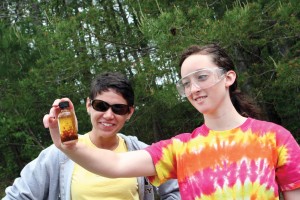
After the chemical analysis, the excitement rises as Golden and her fellow students dig through muddy plants for tadpoles. Savannah Long (WC ’15) makes a special discovery. “I got one with legs!” she shouts as she fishes a Darwinian-looking tadpole from the muck. All the others are still legless, most of them destined to become fish food in the lake.
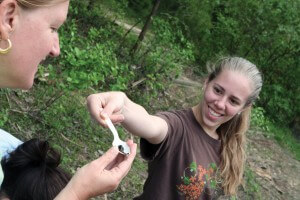
“You’re applying what you learn,” says Davis, “and that’s what I like the most about the Honors Program.” Broadwell agrees, proudly presenting a number of midge flies and worms that she located well off the beaten path at the lake.
Research Librarian Kern, who helped with the first sustainability-themed Junior Honors Seminar in 2008, echoes Zayas’ sentiments. The honors seminars bring “students of different majors together in one multidisciplinary course,” she says. “They are often surprised to find out how much they want to know things that aren’t in their chosen field.”
One of Honors Chair Winter Elliott’s former students, Monique Wimby WC ’12, graduated in only three years with a double major in English and dance – illustrative of the kind of energy, drive, and intelligence that makes for a great honors student. But she bought into one of the central teachings of Brenau honors classes – that small or individual efforts can be world-changing. After her May graduation, she started a field internship at the National Organization for Women in Washington, D.C., for a chance to figure out how she can “change some facet of the world for the better. “
Students often find their voices through honors program work – figuratively and literally. Another one of those Four Portals we talk so much about at Brenau is communication, and to help cover that in all facets of the program is a redoubled emphasis on speaking skills.
On another of my field trips for the “Agriculture and Food Production” honors course, I took the group to the Fieldale Company feed mill in Baldwin, Ga. They were certainly wowed by the climb to the top of the 279-foot tower, but they were equally impressed as mill manager Emory Forrest explained the workings of – and in today’s environment the contextual significance of – the largest chicken feed operation in the Southeastern United States.
“They showed us exactly what goes into the chicken feed,” says Stefanie Lehmann, WC’13, winner of the 2012 Baxter-Bryan scholarship. “Those stories that claim that the feed is full of steroids and antibiotics and junk aren’t true.”
Another myth busted? Perhaps, but certainly, ahem, food for thought for another spirited debate.
After an Honors Program poetry recital with classmate Wimby, Chloe Golden summed up her experiences in the honors classes. “I write for pleasure,” she says, “but one of the most interesting things about the program is that you get to do all these different things. One day you’re scooping up water from the lake, then you’re reading Jane Austen, and then you’re helping with an Earth Day event for a leadership class. It challenges you in ways you don’t have in regular courses – and I wouldn’t miss it for the world.”
– by Rudi Kiefer
Dr. Rudi Kiefer, who has been responsible for the Brenau Web site, returned to the academic side of the university this fall term as a professor of physical science and director of the Brenau sustainability initiative.
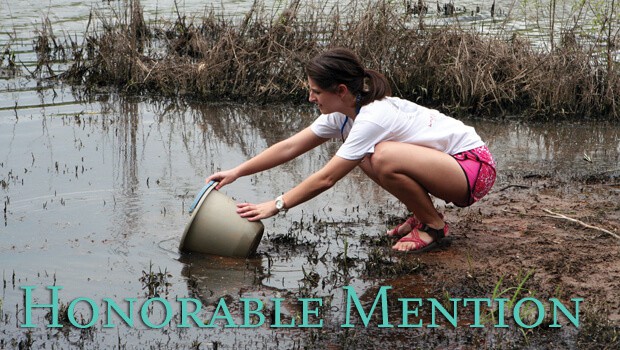

Great article, Rudi!! Give us a holler some day! -jim